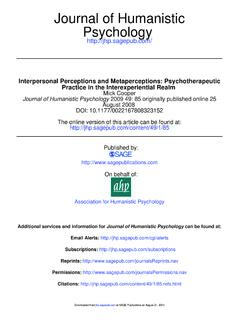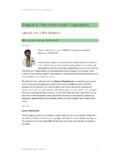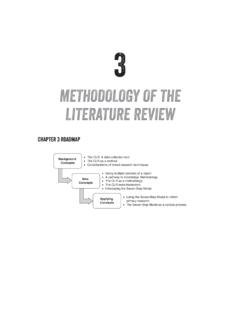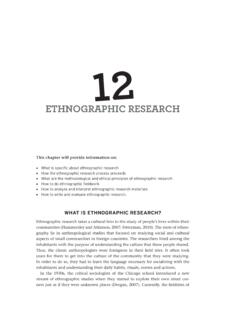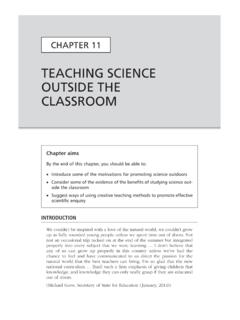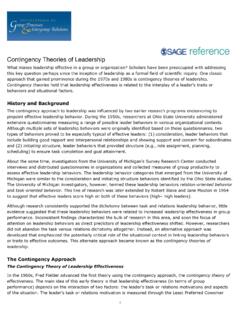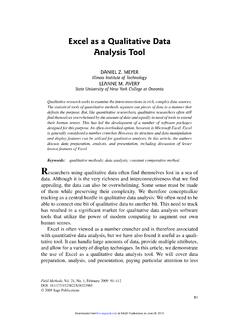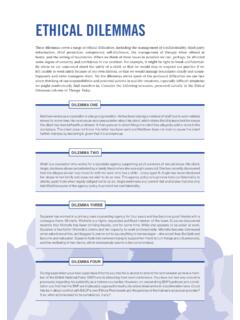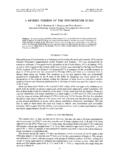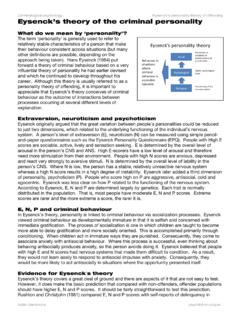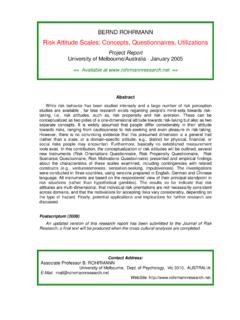Transcription of Experimental Psychology Practical Report
1 Structural featuresCommunication featuresExperimental Psychology Practical ReportPersonalityIntroduction:Personalit y is a form of folk Psychology ; everyone has their own ideas about what personality is. personality can be defined as the characteristics that account for consistent patterns of feeling, thinking and behaviour. People s personality can be described as traits and types (Gross, 2015). personality traits are variables that lie somewhere on a continuum or scale, with all people lying somewhere on the scale. For example, the personality traits extroversion and introversion lie at opposite ends of the scale, with degrees of variation lying between them. A personality trait is an enduring characteristic of an individual which may have biological origins or be shaped by early environment. A personality type is a cluster of several traits and instead of being a continuous variable, is a binary variable, people either have the personality type or they don t.
2 An example is Type A personality (Friedman & Rosenman, 1974) which is when people are aggressive, dominating and are very are several methods for studying personality , one of which is self- Report questionnaires. Although this method has many benefits, there are also many problems. Examples of possible problems include the fact that some people may not always be completely trustworthy, or the role that social desirability plays, whereby people may want to present themselves as better than they actually consider themselves to be. Another issue is the problem of separating cause and effect. For example, depressed subjects may inherently say yes to questions such Do you tend to worry a lot? The questionnaire needs to have equal numbers of positive and negatively loaded questions, as some people have a tendency to respond in the same way to every question (always say yes or always say no).Questionnaires need to be designed carefully to show reliability, stability and validity.
3 Reliability, in the sense of whether the various questions measure the same given quality, can be tested by seeing if the first half of the questionnaire gives the same result as the second half. Stability can be tested to see if people perform consistently over time, and validity can be tested by seeing whether the test correlates with an independent measure of the same trait (Myers, 2012).In a Psychology lab Report , there is usually an abstract which functions to summarise the entire contents of the Report . Sometimes your tutor will not expect you to write an abstract, as shown in this sample. Check this with your tutor. See Ch 2, Getting started on your lab reportSources cited to support the information. Introduction provides the background to the study and defines key terms. Cautious language for making suggestions about ch 7,Using cautious languageParagraph giving information about the different research methods available to study this area, with advantages and disadvantages simple tense used to give defninitions and are many different traits, and factor analysis aims to reduce this number to the core underlying dimensions which account for the majority of the variation between the subjects.
4 There are two main models that have been derived by factor analysis, Eysenck s 3-factor PEN model and Costa and McCrae s The Big Five (Myers, 2012). Which of these models is most applicable represents one of the many ongoing debates in personality :For this experiment, the subjects, all of whom were university students aged between 19 and 22 years, each completed a Barratt questionnaire which consisted of 30 statements and the subject had to circle the number that most accurately described them (1=rarely/never, 2=occasionally, 3=often, 4=almost always/always). The subjects were told not to hesitate for too long over any individual answers. Each subject was assigned a subject ID and the subject s gender was coded as male=0 and female=0. The Barratt questionnaire denotes the Barratt Impulsivity Scale (v11, Patton et al 1995) which measures motor, attentional and non-planning impulsivity. The questionnaire was scored by summing the individual answers in each of the different categories.
5 Ten of the questions were scored backwards as they were statements that indicated a lack of impulsivity. The total score was entered into a results table along with the subject ID and gender second task performed was the Affective Go-No-Go Task which involved emotional processing and inhibitory control. This task was performed on the computer programme, PsyScope, and each subject had to enter their subject ID number and choose either heads or tails. This random choice determined which block they started with (happy or sad) to ensure that the results were not based on which block was responded to first (habit-forming) as this could cause a positive or negative each block, 18 words are presented and each word is either positive or negative valence. In the happy blocks, which correspond to the positive valence, the subject must respond to the happy words by pressing the space bar as quickly as possible, but make no response to the sad words.
6 Similarly, in the sad blocks the subject must respond by pressing the space bar as quickly as possible to the sad words but must not respond to the happy words. The subject knows which block they are in by a set of instructions and if they make an incorrect response then the subject hears a buzzer sound through the Method section describes the steps taken and includes information about the participants Past tense, usually passive, used to describe what was done (the steps)headphones they are wearing. The number of omission errors (failure to respond to targets), commission errors (impulsive responses to distracters) and the affective bias (the reaction time difference between positive and negative valences) were all recorded for each of the results gained from this year were pooled with four other years results in order to reduce the effect of small anomalies, which, in a smaller results group, may appear as significant (Myers, 2012).
7 Results: The results from this experiment are given below in various formats. Table 1 provides a summary of the means for each category in each of the tests, along with standard deviations. Figure 1 provides a visual representation of the frequency of distribution of scores on the Barrett questionnaires. Table 1: Descriptive statisticsBarratt Impulsivity Scale TotalAffective Go-No Go TaskAttentionMotorNon-planningTotalOmiss ion ErrorsCommission ErrorsAffective BiasMean ( ) deviation ( ) Total ScoreHistogramFigure 1: Frequency of scores on the Barrett testPresent simple tense used to refer to and describe figures, tables, and chartsAccurate and effective use of tables and figures, with captions positioned appropriately (above a table, and below a figure). (see Chapter 2, Getting started on your lab Report )To test if there are any significant differences between the two genders on the Barratt Total Score an independent samples t-test which did not assume equal variances was used, where H0 is that male = female and H1 is that male = femaleTable 2: t-Test: Two-Sample Assuming Unequal variances: Variable 1 (Male)Variable 2 (Female) Mean Difference0df234t (T<=t) Critical Correlations of the Barratt Total Score with the key variables from the Affective Go-No Go task s were calculated using the Pearson s Product-Moment Correlation Co-efficient.
8 To test the significance of these r-values the following equation was used:t=r x (n 2) (1 r )T-critical for a two-tailed test with = and df(392) is 3: Correlations with the Barrett Total ScoreCorrelations with the Barratt Total Score T-valueOmission order to see what extent there is correlation between the key variables of the Affective Go-NO-Go Task ad the Barrett Total Score a scatter graph is shown below (Figures 2, 3, and 4).Correct spacing for equations(see Chapter 2, Getting started on your lab Report )051015202530020406080100120 Number of Omission ErrorsBarratt Total ScoreOmission ErrorsFigure 2: Omission errors 010203040020406080100120 Number of Commission ErrorsBarratt Total ScoreCommission ErrorsFigure 3: Commission Errors-150-100-5005010015002040608010012 0 Affective BiasBarratt Total ScoreAffective BiasFigure 4: Affective BiasDiscussion:Table 1, showing descriptive statistics, describes the mean and standard deviation of the key variables in the Barratt questionnaire and the Affective Go-No Go Task.
9 From this table it is possible to see that, for some variables such as the affective bias, there is a large range of results due to the high values for the standard histogram shown in Figure 1 is not a perfect normal distribution curve though there is a definite maximum frequency at 66 for the Barratt Total Score and either side of this value the frequency decreases, though it does not follow the typical bell-shaped curve. From Figure 1, it is possible to say that BIS impulsivity is normally distributed in our gender difference on the Barratt Total Score was also examined using an independent samples t-test. A t-value of was calculated, where the critical t-value was This means that there is not statistical evidence to reject H0 and to suggest that there is a significant difference between male and female s Barratt Total Score even though the mean values differ (male: , ). Therefore, males and females do not differ in BIS PPMCC of the Barratt Total Score with the AGNG commission errors was which is a very weak positive correlation.
10 The hypothesis stated that the AGNG commission errors would correlate significantly with BIS impulsivity as commission errors as impulsive responses to distracters. A t-value of was calculated which is much greater than the critical t-value (= ), so there is no statistical evidence to reject H0. Therefore, the AGNG commission errors have no significant correlation with the Barratt Total hypothesis also stated that the AGNG omission errors and affective bias would not correlate significantly with BIS impulsivity. The PPMCC was and respectively, which are also very weak positive correlations, though the correlation between the AGNG affective bias and BIS impulsivity is stronger than between the AGNG commission errors and BIS impulsivity. This is not what was affective bias is calculated as the negative reaction time subtracted from the positive reaction time. As the correlation between the affective bias and the Barratt Total Score is very slightly positive this means that as the Barratt Total Score increases, the difference between the positive and negative reaction times increases very slightly towards a positive affective Present simple tense used to refer to and describe significance of resultsLanguage of hypothesis: conditional It is sometimes acceptable to use personal language in Psychology reports.
